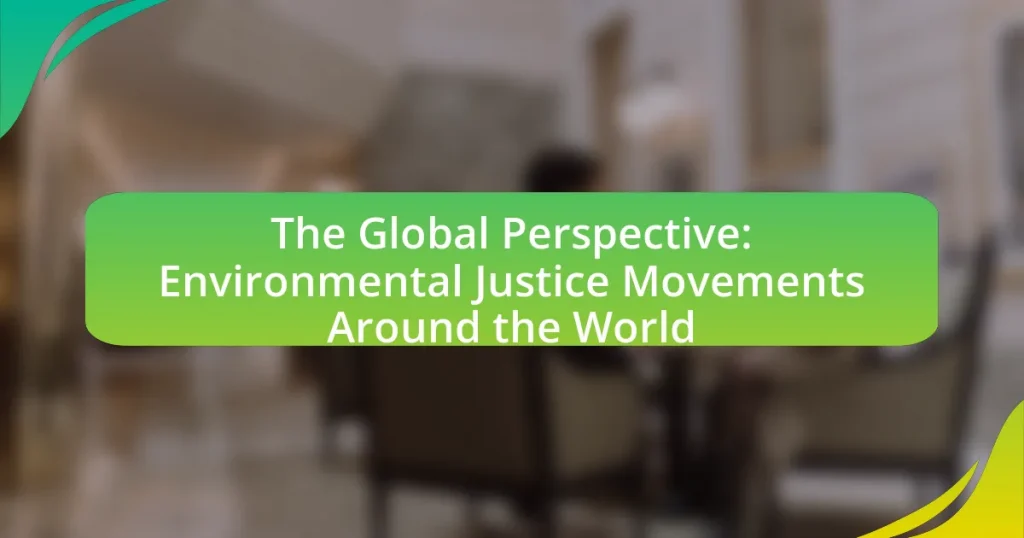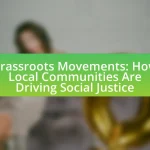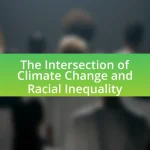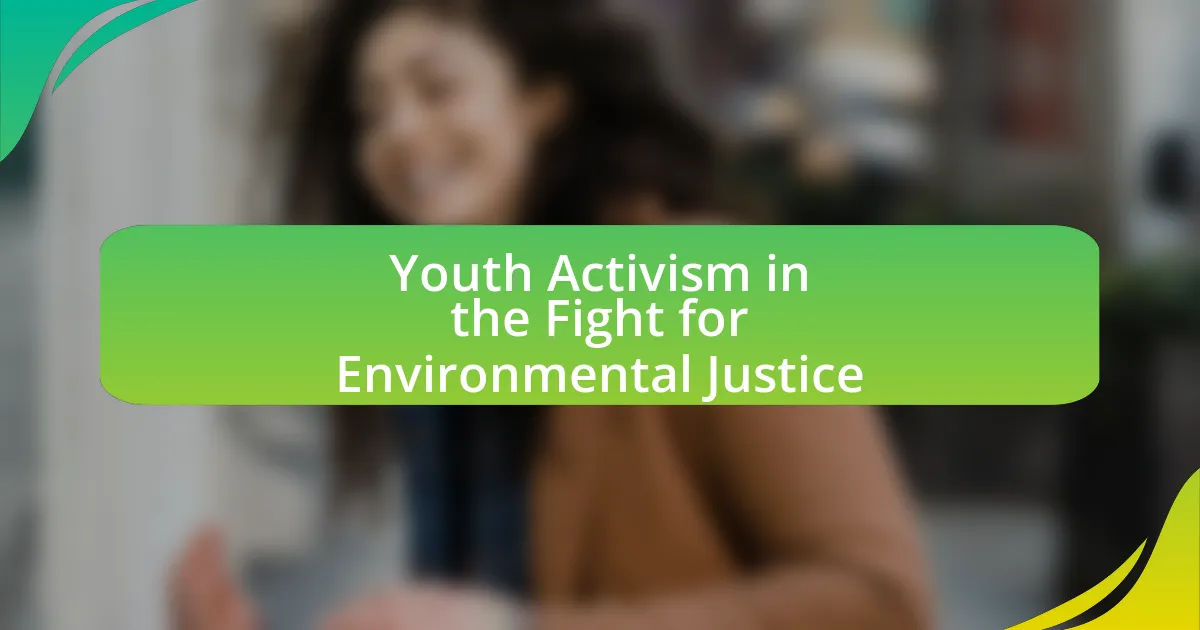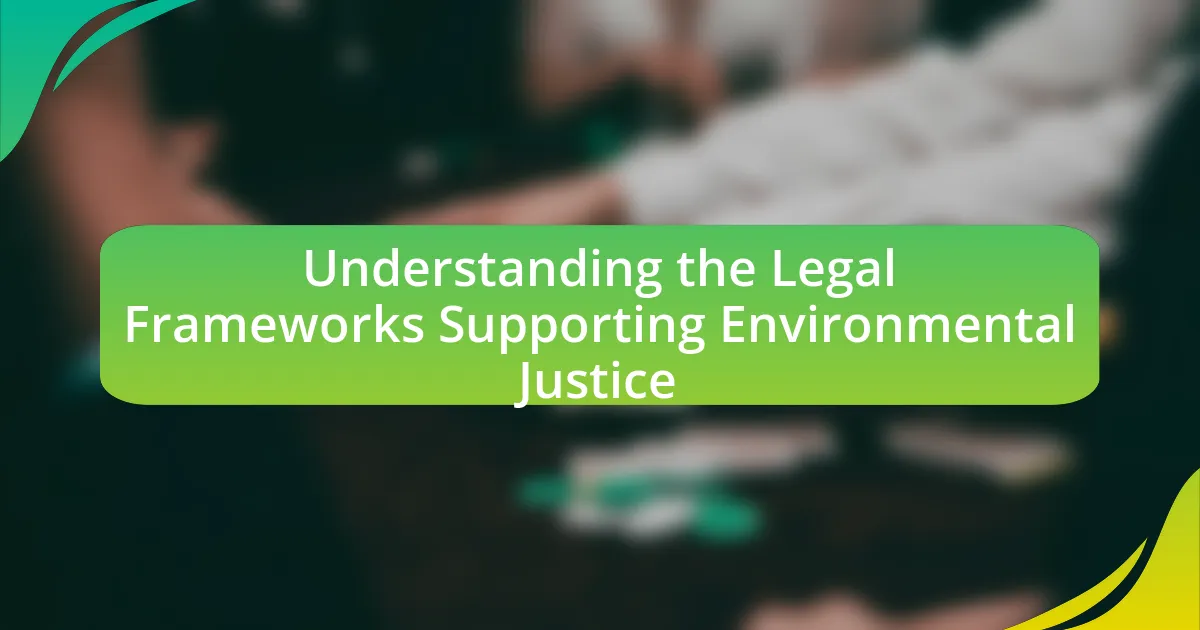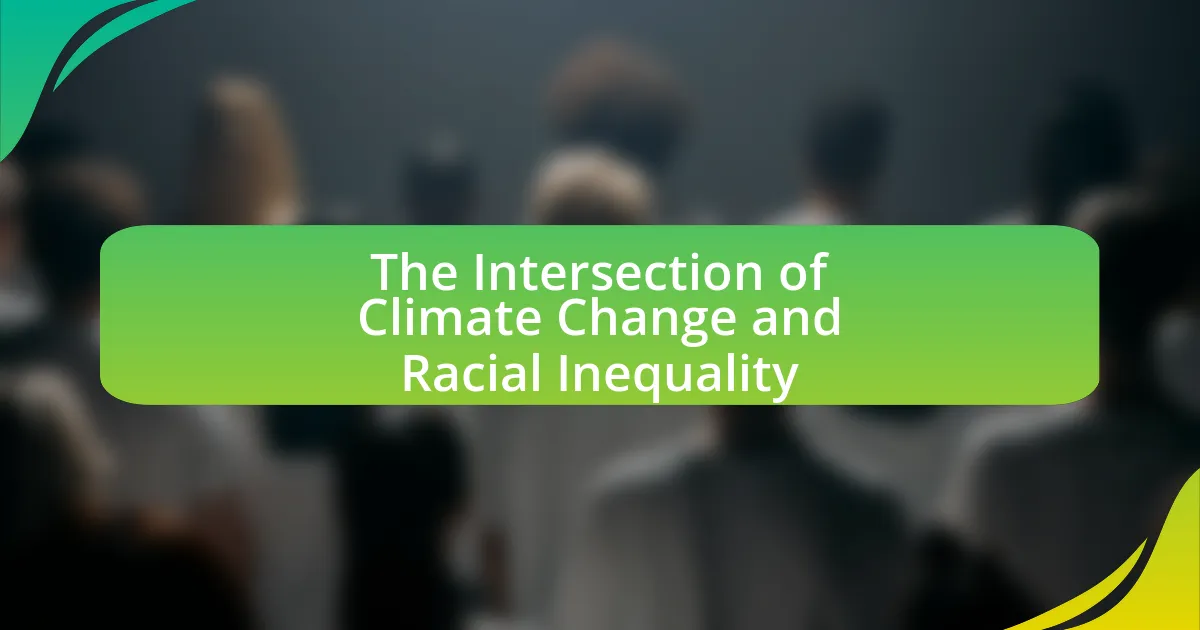Environmental Justice Movements are organized efforts aimed at addressing the unequal environmental burdens faced by marginalized communities globally. The article explores the emergence of these movements, highlighting historical events such as the 1982 Warren County protests, which catalyzed awareness of environmental racism. It examines the cultural contexts that influence these movements, the importance of Environmental Justice in today’s world, and the intersection with human rights. Additionally, the article discusses the unique challenges faced by these movements in both developed and developing countries, the strategies employed for advocacy, and the significant impacts on policy changes and community empowerment. Finally, it outlines how individuals can support these movements and the resources available for engagement.
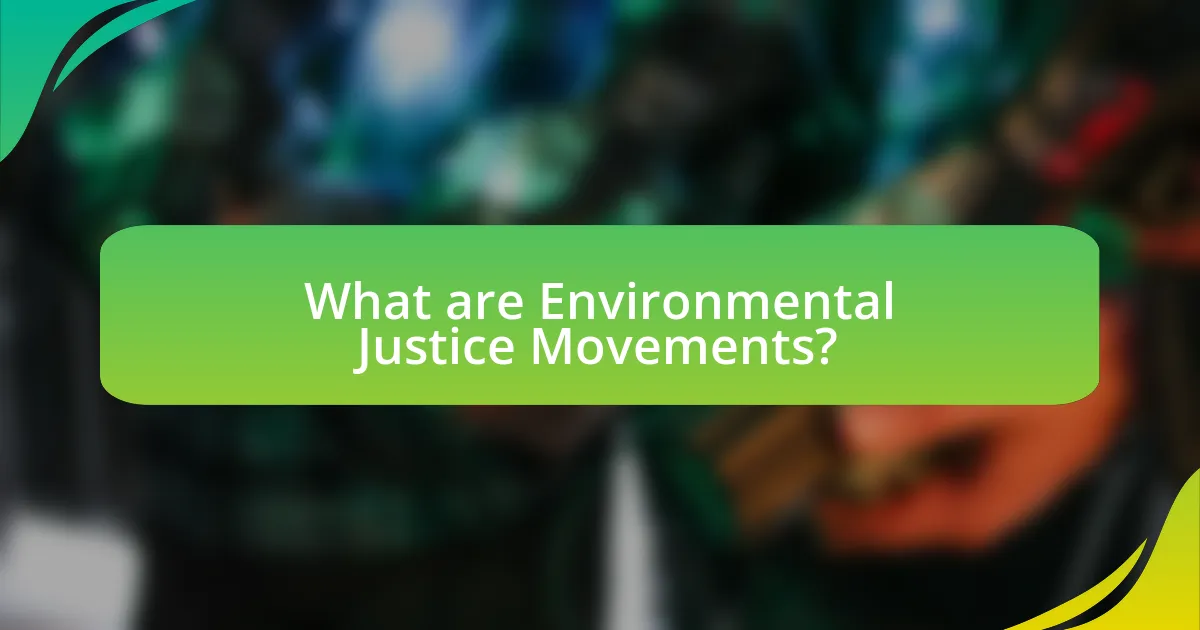
What are Environmental Justice Movements?
Environmental Justice Movements are organized efforts aimed at addressing the disproportionate environmental burdens faced by marginalized communities. These movements advocate for equitable distribution of environmental benefits and protections, emphasizing that all individuals, regardless of race, ethnicity, or socioeconomic status, should have the right to a healthy environment. For example, the United States’ Environmental Justice Movement gained momentum in the 1980s, highlighted by the 1982 protests against a hazardous waste landfill in Warren County, North Carolina, which predominantly affected African American residents. This event catalyzed awareness and activism around environmental racism, leading to the establishment of policies aimed at ensuring environmental equity.
How do Environmental Justice Movements emerge globally?
Environmental Justice Movements emerge globally through the intersection of social inequality, environmental degradation, and grassroots activism. These movements often arise in response to marginalized communities facing disproportionate environmental harms, such as pollution and resource depletion, which are exacerbated by systemic injustices. For instance, the 1982 protests in Warren County, North Carolina, against a hazardous waste landfill marked a pivotal moment, highlighting the link between race, poverty, and environmental policy. This event catalyzed awareness and mobilization, leading to the establishment of the environmental justice framework that emphasizes the rights of affected communities. Furthermore, global communication networks and social media have facilitated the spread of information and solidarity among diverse groups, allowing local struggles to gain international attention and support.
What historical events have shaped Environmental Justice Movements?
The historical events that have shaped Environmental Justice Movements include the 1982 Warren County protests against toxic waste dumping in North Carolina, which marked a pivotal moment in the recognition of environmental racism. This event highlighted the disproportionate impact of environmental hazards on marginalized communities, leading to increased activism and awareness. Additionally, the 1991 First National People of Color Environmental Leadership Summit established key principles for environmental justice, emphasizing the need for equitable treatment and involvement of all people in environmental decision-making. These events, among others, have significantly influenced the trajectory and goals of Environmental Justice Movements globally.
How do cultural contexts influence these movements?
Cultural contexts significantly influence environmental justice movements by shaping the values, beliefs, and priorities of communities involved. For instance, in Indigenous cultures, a deep connection to land and nature drives activism, as seen in movements like the Standing Rock protests against the Dakota Access Pipeline, where Indigenous groups emphasized their spiritual relationship with the land. Additionally, cultural narratives around environmental stewardship can mobilize communities; for example, in many African nations, traditional practices that prioritize communal land use inform resistance against exploitative resource extraction. These cultural frameworks not only dictate the strategies employed in activism but also influence the framing of issues, as seen in the integration of local languages and customs in campaigns, which enhances community engagement and solidarity.
Why is Environmental Justice important in today’s world?
Environmental Justice is important in today’s world because it addresses the disproportionate environmental burdens faced by marginalized communities. These communities often experience higher exposure to pollutants, lack access to clean water, and suffer from health disparities linked to environmental degradation. For instance, a report by the United Nations highlights that low-income and minority populations are more likely to live near hazardous waste sites, leading to increased health risks. This inequity necessitates a focus on Environmental Justice to ensure fair treatment and meaningful involvement of all people in environmental decision-making processes, thereby promoting social equity and sustainability.
What are the social implications of Environmental Justice?
The social implications of Environmental Justice include the promotion of equitable treatment and involvement of all individuals in environmental decision-making processes, particularly marginalized communities. This approach addresses systemic inequalities by ensuring that vulnerable populations are not disproportionately affected by environmental hazards, such as pollution and climate change. For instance, studies have shown that low-income and minority communities often face higher exposure to toxic waste and industrial pollution, leading to health disparities. The U.S. Environmental Protection Agency reported that communities of color are more likely to live near hazardous waste sites, highlighting the need for policies that rectify these injustices. By advocating for Environmental Justice, societies can foster social cohesion, enhance public health, and empower communities to participate in sustainable development initiatives.
How does Environmental Justice intersect with human rights?
Environmental justice intersects with human rights by asserting that all individuals have the right to a healthy environment, which is essential for the enjoyment of fundamental human rights such as health, life, and well-being. This intersection is evident in international frameworks like the United Nations Declaration on the Rights of Indigenous Peoples, which recognizes the importance of environmental protection for the rights of indigenous communities. Furthermore, studies show that marginalized communities often face disproportionate environmental hazards, highlighting the need for equitable policies that address both environmental and human rights issues. For instance, the 2018 report by the UN Special Rapporteur on human rights and the environment emphasizes that environmental degradation directly impacts the realization of human rights, reinforcing the necessity of integrating environmental justice into human rights advocacy.

What are the key characteristics of Environmental Justice Movements worldwide?
Environmental Justice Movements worldwide are characterized by their focus on the equitable distribution of environmental benefits and burdens, advocating for marginalized communities disproportionately affected by environmental hazards. These movements emphasize grassroots activism, community engagement, and the intersectionality of social justice issues, highlighting how race, class, and economic status influence environmental policies. For instance, the United States’ Environmental Justice Movement emerged in the 1980s, addressing the placement of hazardous waste sites in low-income neighborhoods, which led to the establishment of the U.S. Environmental Protection Agency’s Office of Environmental Justice in 1994. Globally, movements like the Indigenous-led protests against resource extraction in the Amazon rainforest illustrate the fight for land rights and environmental protection, showcasing the universal demand for justice and sustainability.
How do different regions approach Environmental Justice?
Different regions approach Environmental Justice through varying frameworks and policies that reflect their unique social, economic, and environmental contexts. In the United States, for instance, the Environmental Protection Agency (EPA) emphasizes community engagement and regulatory measures to address disproportionate environmental burdens on marginalized communities. In contrast, Latin American countries often integrate indigenous rights into their environmental policies, recognizing the traditional knowledge and land rights of indigenous populations as essential to achieving justice. In Europe, the approach tends to focus on sustainable development and the precautionary principle, aiming to prevent environmental harm before it occurs. These regional differences highlight how local histories, cultures, and governance structures shape the implementation of Environmental Justice initiatives.
What are the unique challenges faced by Environmental Justice Movements in developed countries?
Environmental Justice Movements in developed countries face unique challenges such as systemic inequality, political resistance, and the complexity of regulatory frameworks. Systemic inequality manifests in the disproportionate impact of environmental hazards on marginalized communities, often leading to inadequate representation in decision-making processes. Political resistance arises from entrenched interests that prioritize economic growth over environmental protection, making it difficult for movements to gain traction. Additionally, the complexity of regulatory frameworks can hinder effective advocacy, as movements must navigate a labyrinth of local, state, and federal laws that may not adequately address environmental justice issues. These challenges are evidenced by studies showing that low-income and minority communities in developed nations often experience higher exposure to pollution and environmental degradation, highlighting the urgent need for targeted advocacy and reform.
What specific issues do developing countries encounter in their Environmental Justice efforts?
Developing countries encounter significant issues in their Environmental Justice efforts, primarily due to limited resources, weak governance, and socio-economic challenges. Limited financial resources hinder the implementation of effective environmental policies and regulations, as many developing nations struggle to allocate funds for environmental protection initiatives. Weak governance often results in inadequate enforcement of environmental laws, allowing industries to exploit natural resources without accountability. Additionally, socio-economic challenges, such as poverty and lack of education, can lead to marginalized communities being disproportionately affected by environmental degradation, as they lack the means to advocate for their rights or access legal recourse. These factors collectively impede the progress of Environmental Justice movements in developing countries.
What strategies do Environmental Justice Movements employ?
Environmental Justice Movements employ strategies such as grassroots organizing, policy advocacy, and coalition building to address environmental inequalities. Grassroots organizing involves mobilizing local communities to raise awareness and demand action against environmental injustices, often leading to increased community engagement and empowerment. Policy advocacy focuses on influencing legislation and regulations to ensure equitable environmental protections, exemplified by movements pushing for stronger environmental laws that consider marginalized populations. Coalition building brings together diverse groups, including environmentalists, social justice advocates, and affected communities, to create a unified front that amplifies their collective voice and impact. These strategies have been effective in various contexts, such as the fight against toxic waste dumping in low-income neighborhoods, demonstrating the movements’ ability to effect change through organized efforts.
How do grassroots organizations contribute to these movements?
Grassroots organizations contribute to environmental justice movements by mobilizing local communities, raising awareness, and advocating for policy changes. These organizations often serve as the voice of marginalized populations, highlighting issues such as pollution and land rights that disproportionately affect them. For instance, the work of organizations like the Indigenous Environmental Network has been pivotal in addressing the impacts of climate change on Indigenous lands, demonstrating how grassroots activism can lead to significant policy shifts and increased visibility for environmental justice issues.
What role does policy advocacy play in Environmental Justice Movements?
Policy advocacy is crucial in Environmental Justice Movements as it seeks to influence legislation and policy decisions that address environmental inequalities. By mobilizing communities and stakeholders, these movements aim to ensure that marginalized populations have a voice in environmental decision-making processes. For instance, the Environmental Justice Movement in the United States has successfully advocated for policies like the National Environmental Policy Act, which requires federal agencies to consider environmental justice in their actions. This demonstrates how policy advocacy not only raises awareness but also leads to tangible changes in laws that protect vulnerable communities from environmental harm.
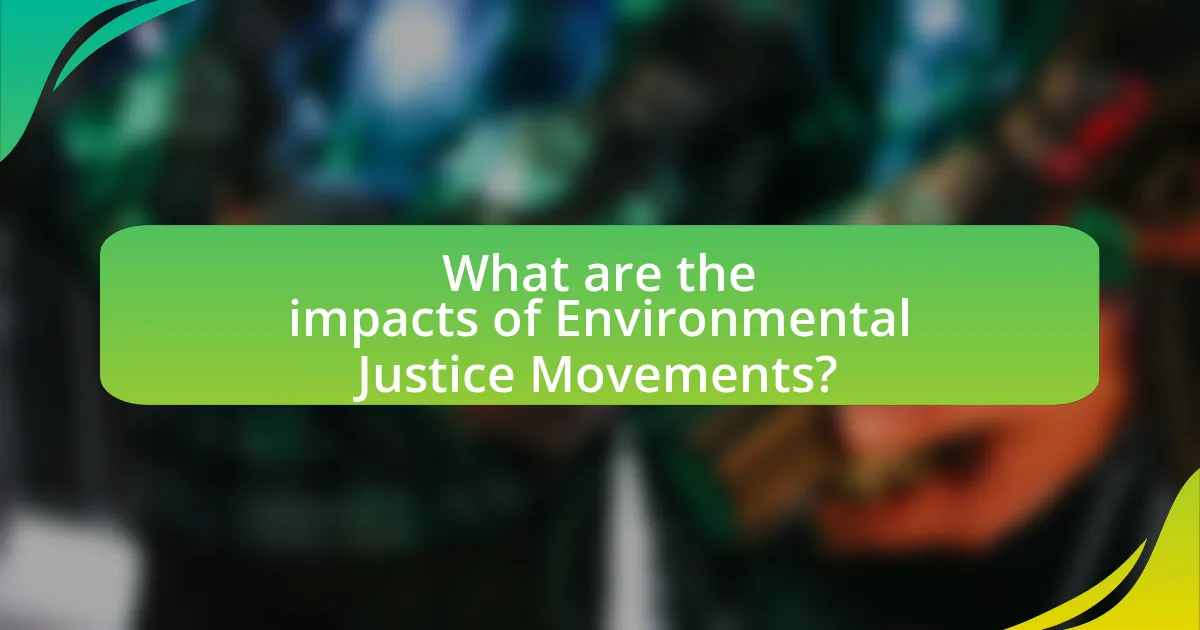
What are the impacts of Environmental Justice Movements?
Environmental Justice Movements significantly impact policy changes, community empowerment, and environmental health. These movements advocate for the equitable distribution of environmental benefits and burdens, leading to legislative reforms such as the establishment of stricter pollution controls and the recognition of marginalized communities’ rights. For instance, the U.S. Environmental Protection Agency’s 1994 Executive Order 12898 aimed to address environmental justice in minority and low-income populations, demonstrating the influence of these movements on governmental policy. Additionally, they foster community engagement and awareness, empowering local populations to advocate for their rights and participate in decision-making processes regarding environmental issues. This empowerment is evidenced by grassroots organizations that have successfully challenged industrial projects harmful to their communities, such as the fight against the Dakota Access Pipeline by the Standing Rock Sioux Tribe. Overall, Environmental Justice Movements play a crucial role in shaping a more equitable and sustainable environmental landscape.
How do these movements affect policy changes?
Environmental justice movements significantly influence policy changes by raising awareness and mobilizing public support for equitable environmental practices. These movements often highlight the disproportionate impact of environmental degradation on marginalized communities, prompting policymakers to address these disparities. For instance, the environmental justice movement in the United States led to the establishment of the Environmental Protection Agency’s Office of Environmental Justice in 1994, which aims to ensure that all communities receive fair treatment regarding environmental laws and policies. This demonstrates how grassroots activism can lead to institutional changes that prioritize social equity in environmental governance.
What successful case studies illustrate the impact of Environmental Justice Movements?
Successful case studies illustrating the impact of Environmental Justice Movements include the fight against the Dakota Access Pipeline and the Flint water crisis. In the Dakota Access Pipeline case, the Standing Rock Sioux Tribe mobilized against the pipeline’s construction, citing threats to water supply and sacred lands. This movement garnered national attention, leading to a temporary halt in construction and increased awareness of Indigenous rights and environmental protection. In the Flint water crisis, community activism highlighted the severe health impacts of lead-contaminated water, resulting in federal intervention and policy changes aimed at improving water quality and infrastructure in marginalized communities. These examples demonstrate how grassroots activism can lead to significant policy changes and heightened awareness of environmental justice issues.
How do Environmental Justice Movements influence public awareness and education?
Environmental Justice Movements significantly enhance public awareness and education by advocating for the rights of marginalized communities affected by environmental issues. These movements mobilize grassroots activism, which raises awareness about the disproportionate impact of environmental hazards on low-income and minority populations. For instance, the United Church of Christ’s 1987 report, “Toxic Wastes and Race in the United States,” highlighted that communities of color were more likely to be located near hazardous waste sites, prompting increased public discourse and educational initiatives around environmental racism. Furthermore, these movements often utilize social media and community workshops to disseminate information, empowering individuals with knowledge about their rights and environmental health. This combination of advocacy and education fosters a more informed public that can engage in policy discussions and demand equitable environmental practices.
What challenges do Environmental Justice Movements face today?
Environmental Justice Movements today face significant challenges, including systemic inequality, lack of political representation, and insufficient funding. Systemic inequality manifests in the disproportionate impact of environmental hazards on marginalized communities, often leading to health disparities and economic disadvantages. Additionally, these movements frequently struggle with limited political representation, which hampers their ability to influence policy decisions that affect their communities. Furthermore, inadequate funding restricts their capacity to mobilize resources, conduct research, and advocate effectively for change. According to a report by the United Nations Environment Programme, marginalized groups are often excluded from decision-making processes, exacerbating their vulnerability to environmental injustices.
How do economic interests conflict with Environmental Justice goals?
Economic interests often conflict with Environmental Justice goals by prioritizing profit over equitable resource distribution and environmental protection. For instance, industries may exploit natural resources in marginalized communities, leading to pollution and health hazards that disproportionately affect these populations. A study by the United Nations Environment Programme highlights that low-income and minority communities frequently bear the brunt of environmental degradation due to industrial activities, which are driven by economic incentives. This dynamic creates a cycle where economic growth is pursued at the expense of environmental health and social equity, undermining the principles of Environmental Justice.
What role does climate change play in shaping the future of these movements?
Climate change significantly influences the future of environmental justice movements by intensifying social inequalities and mobilizing communities for action. As climate change exacerbates issues such as resource scarcity, displacement, and health risks, marginalized populations often bear the brunt of these impacts, prompting them to advocate for their rights and seek equitable solutions. For instance, the Intergovernmental Panel on Climate Change (IPCC) reports that vulnerable communities are disproportionately affected by climate-related disasters, which fuels grassroots activism and demands for policy changes. This growing awareness and urgency among affected groups are reshaping the strategies and goals of environmental justice movements globally, leading to increased collaboration and intersectionality in their efforts.
What can individuals do to support Environmental Justice Movements?
Individuals can support Environmental Justice Movements by actively participating in advocacy efforts, such as joining local organizations that focus on environmental issues affecting marginalized communities. Engaging in community outreach and education helps raise awareness about environmental injustices, which is crucial for mobilizing support. Additionally, individuals can support policies that promote equitable environmental practices by voting for representatives who prioritize environmental justice and by contacting lawmakers to express their support for relevant legislation. Research indicates that grassroots movements, like the one led by the Environmental Justice Movement in the United States, have successfully influenced policy changes and raised public awareness about the disproportionate impact of environmental hazards on low-income and minority communities.
How can community engagement enhance the effectiveness of these movements?
Community engagement enhances the effectiveness of environmental justice movements by fostering local ownership and participation in decision-making processes. When communities actively engage, they contribute valuable local knowledge and perspectives that can inform strategies and actions, making them more relevant and impactful. For instance, research by the Environmental Protection Agency indicates that community involvement leads to better environmental outcomes, as seen in the case of the Love Canal incident, where local activism resulted in significant policy changes and remediation efforts. This active participation not only empowers individuals but also builds stronger coalitions, amplifying the movement’s voice and influence in advocating for environmental justice.
What resources are available for those looking to get involved?
Individuals looking to get involved in environmental justice movements can access various resources, including organizations, online platforms, and educational materials. Notable organizations such as the Sierra Club and Greenpeace provide volunteer opportunities, advocacy training, and community engagement initiatives. Online platforms like Change.org and social media groups facilitate activism by connecting individuals with campaigns and local events. Educational resources, including webinars and workshops offered by institutions like the Environmental Justice Resource Center, equip participants with knowledge and skills necessary for effective involvement. These resources collectively support active participation in global environmental justice efforts.
